1993 CHEVROLET SUBURBAN spare tire
[x] Cancel search: spare tirePage 143 of 386
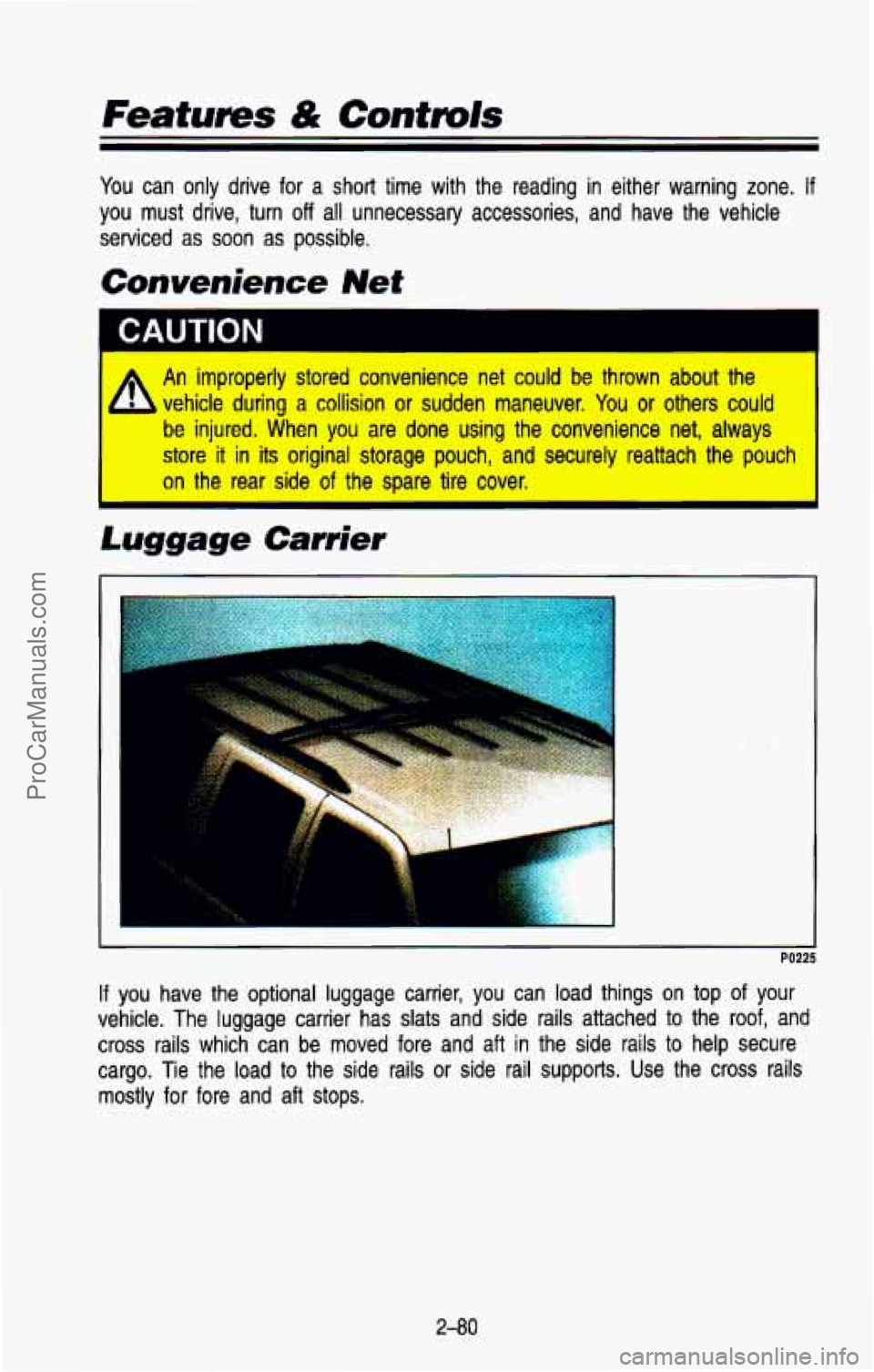
Features & Controls
You can only drive for a short time with the reading in either warning zone. If
you must drive, turn off all unnecessary accessories, and have the vehicle
serviced as soon
as possible.
Convenience Net
CAUTION
A
An improperly stored convenience net could be thrown about the
vehicle during a collision
or sudden maneuver. You or others could
be injured. When you are done using the convenience net, always
store it in its original storage pouch,
and securely reattach the pouch
on the rear side of the spare tire cover.
I
PO22
If you have the optional luggage carrier, you can load things on top of your
vehicle. The luggage carrier has slats and side rails attached \
to the roof, and
cross rails which can be moved fore and aft in the side rail\
s to help secure
cargo. Tie the load to the side rails or side rail supports. Use the cross rails
mostly for fore and aft stops.
2-80
ProCarManuals.com
Page 191 of 386

Driving Guidelines (Utility Models)
This multipurpose passenger vehicle is defined as a utility vehicle in
Consumer Information Regulations issued by the National Highway \
Traffic
Safety Administration (NHTSA) of the United States Department of
Transportation. Utility vehicles have higher ground clearance and\
a narrower
track to make them capable
of performing in a wide variety of off-road
applications. Specific design characteristics give them a higher center of
gravity than ordinary cars. An advantage of the higher ground clearance is a
better view
of the road allowing you to anticipate problems. They are not
designed for cornering at the same speeds as conventional 2-whe\
el drive
vehicles any more than low-slung sports cars are designed to p\
erform
satisfactorily under off-road conditions. If at
all possible, avoid sharp turns or
abrupt maneuvers.
As with other vehicles of this type, failure to operate this
vehicle correctly may result in
loss of control or vehicle rollover.
OffmRoad Driving with Your Four-Wheel
Drive Vehicle
This off-road guide is for vehicles that have four-wheel drive. (Also, see
“Anti-lock Brakes” in the Index.)
If your vehicle doesn’t have four-wheel drive,
you shouldn’t drive off-road unless you’re on
a level, solid surface.
Off-road driving can be great fun. But it does have some definite hazards.
The greatest of these is the terrain itself.
“Off-roading” means you’ve left the great North American road system behind.
Traffic lanes aren’t marked. Curves aren’t banked. There a\
re no road signs.
Surfaces can be slippery, rough, uphill
or downhill. In short, you’ve gone right
back to nature.
Off-road driving involves some new skills. And that’s why it’s very important
that you read this guide. You’ll find many driving tips and suggestions. These
will help make your off-road driving safer and more enjoyable.
Before You Go Off-Roading
There are some things to do before you go out. For example, be sure to
have all necessary maintenance and service work done. Be sure you read \
all
the information about your four-wheel drive vehicle in this manual.
Is there
enough fuel?
Is the spare tire fully inflated? Are the fluid levels up where
they should be? What are the local laws that apply to off-roading where you’ll
be driving?
If you don’t know, you should check with law enforcement people
in the area. Will you be on someone’s private land?
If so, be sure to get the
necessary permission.
4-24
ProCarManuals.com
Page 252 of 386
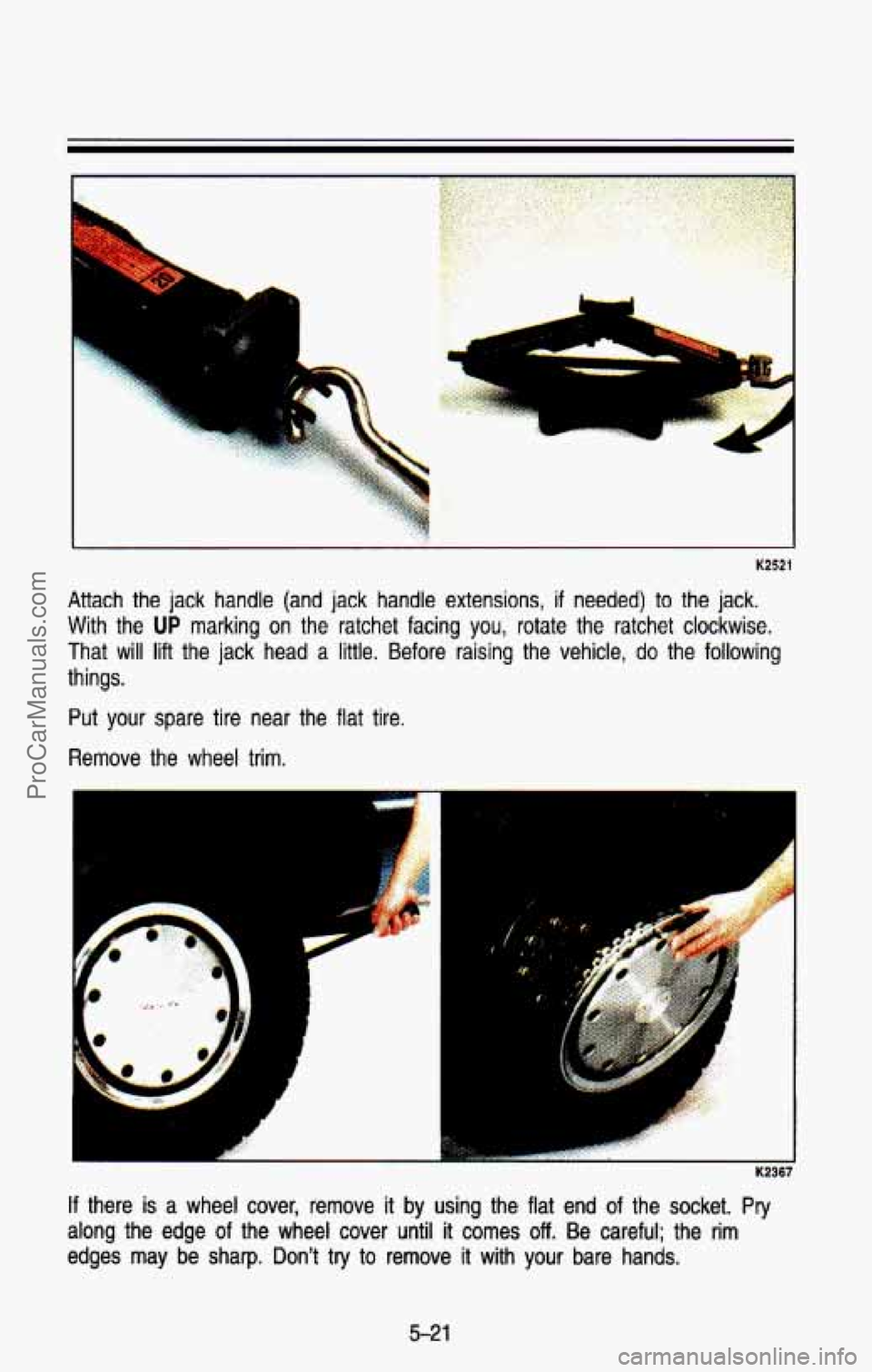
-4
1
K2521
Attach the jack handle (and jack handle extensions, if needed) to the jack.
With the
UP marking on the ratchet facing you, rotate the ratchet clockwise.
That
will lift the jack head a little. Before raising the vehicle, do the following
things.
Put
your spare tire near the flat tire.
Remove the wheel trim.
1 K2367
If there is a wheel cover, remove it by using the flat end of the socket. Pry
along the edge
of the wheel cover until it comes off. Be careful; the rim
edges may be sharp. Don't try to remove
it with your bare hands.
5-21
ProCarManuals.com
Page 255 of 386

NOTICE
- 'sing your vehicle with the jack improperly positioned will damage the
dehicle
or may allow the vehicle to fall off the jack. Be sure to fit the jack
ift head into the proper location before raising your vehicle.
Front Rear
-r-
1
'1
PO288
Raise the vehicle by rotating the ratchet clockwise. Make sure \
the UP
marking faces you. Use the jack handle extensions if the flat \
tire is on the
rear
of the vehicle. Raise the vehicle far enough off the ground so there is
enough room for the spare tire
to fit.
ProCarManuals.com
Page 313 of 386
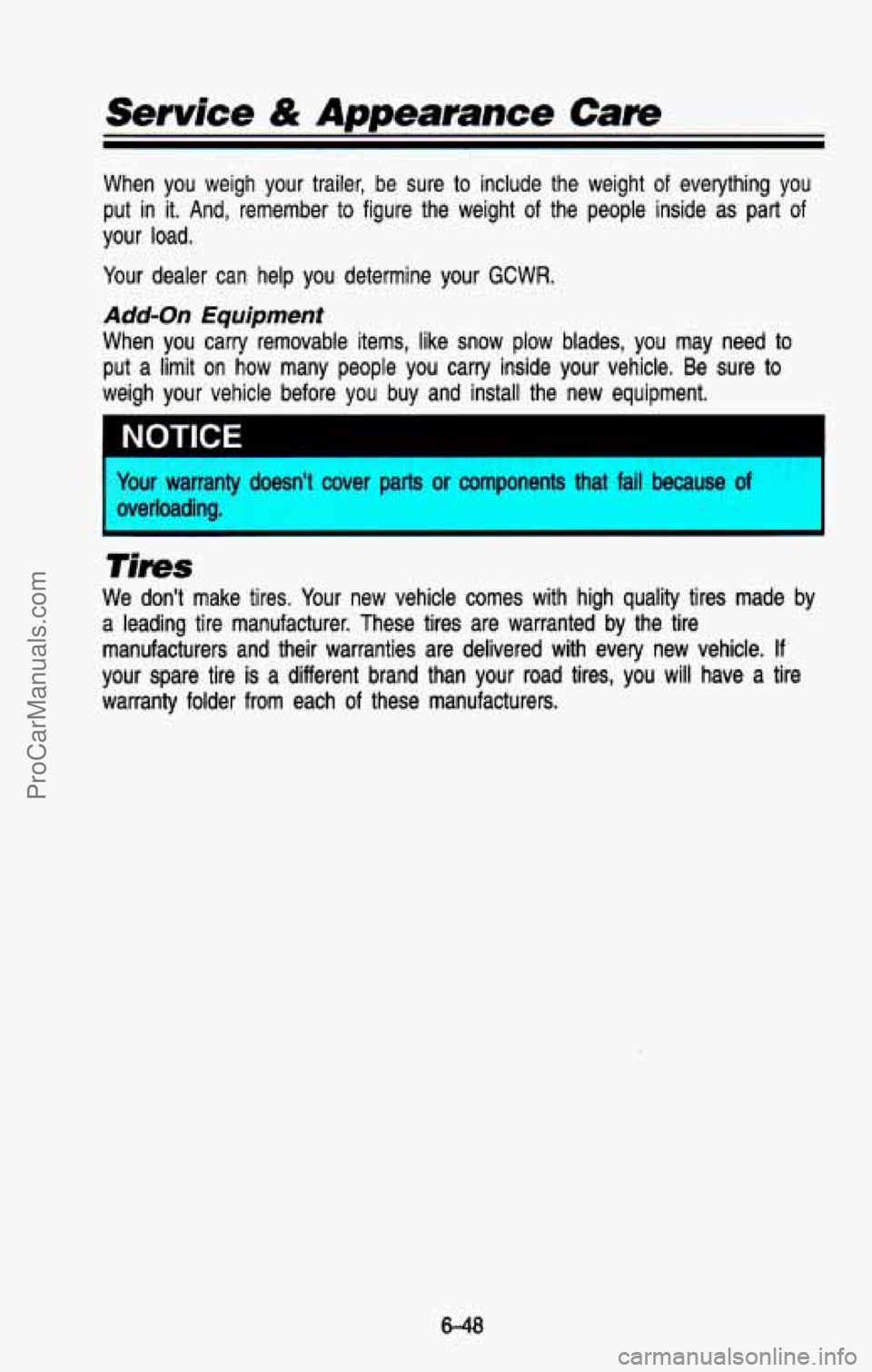
Service & Appearance Care
When you weigh your trailer, be sure to include the weight of everything you
put in it. And, remember to figure the weight of the people inside as part of
your load.
Your dealer can help you determine your
GCWR.
Add-on Equipment
When you carry removable items, like snow plow blades, you may\
need to
put a limit on how many people you carry inside your vehicle. Be sure to
weigh your vehicle before you buy and install the new equipment.
NOTICE 1
rims
We don’t make tires. Your new vehicle comes with high quality tires made by
a leading tire manufacturer. These tires are warranted by the tire
manufacturers and their warranties are delivered with every new \
vehicle.
If
your spare tire is a different brand than your road tires, you will have a tire
warranty folder from each of these manufacturers.
6-40
ProCarManuals.com
Page 315 of 386
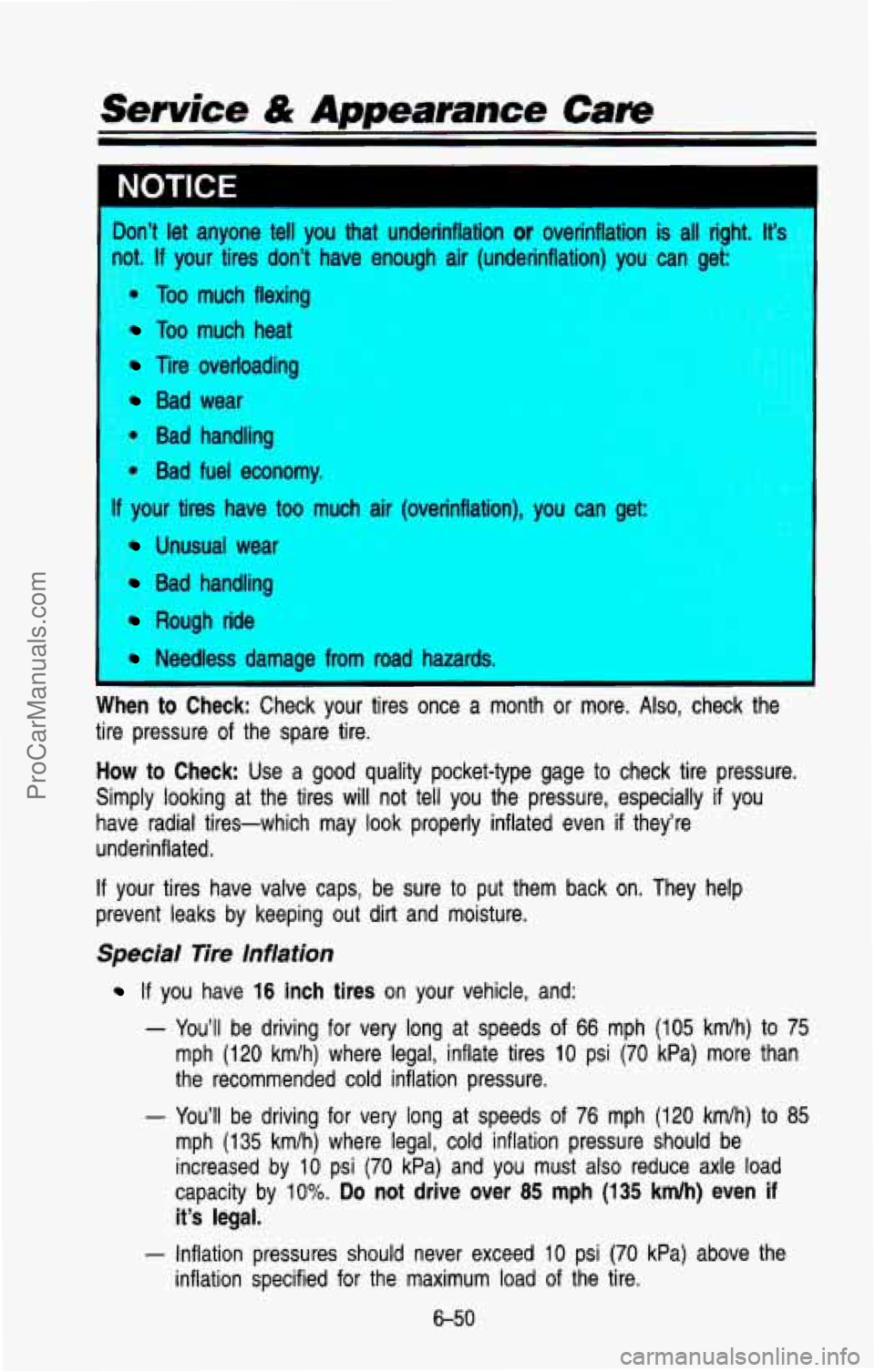
Don’t let anyone tell you that underinflation or overinflation is all right. It’-
9. If your tires don’t have enough air (underinflation) you can get
Too much flexing
Too much heat
tire overloading
Bad wear
Bad handling
Bad fuel economy.
I If your tires have too much air (overinflation), you can get:
Unusual wear
Bad handling
Rough ride
Needless damage from road hazards.
nth
or more. Also, check the
tire pressure of the spare tire.
How to Check: Use a good quality pocket-type gage to check tire pressure.
Simply looking at the tires will not tell you the pressure, e\
specially if you
have radial tires-which may look properly inflated even
if they’re
underinflated.
If your tires have valve caps, be sure to put them back on. The\
y help
prevent leaks by keeping out dirt and moisture.
Special Tire Inflation
If you have 16 inch tires on your vehicle, and:
- You’ll be driving for very long at speeds of 66 mph (105 km/h) to 75
mph
(120 km/h) where legal, inflate tires 10 psi (70 kPa) more than
the recommended
cold inflation pressure,
- You’ll be driving for very long at speeds of 76 mph (120 kmih) to 85
mph (135 km/h) where legal, cold inflation pressure should be
increased
by 10 psi (70 kPa) and you must also reduce axle load
capacity by
10%. Do not drive over 85 mph (135 kmlh) even if
it’s legal.
- Inflation pressures should never exceed 10 psi (70 kPa) above the
inflation specified for the maximum
load of the tire.
6-50
ProCarManuals.com
Page 360 of 386
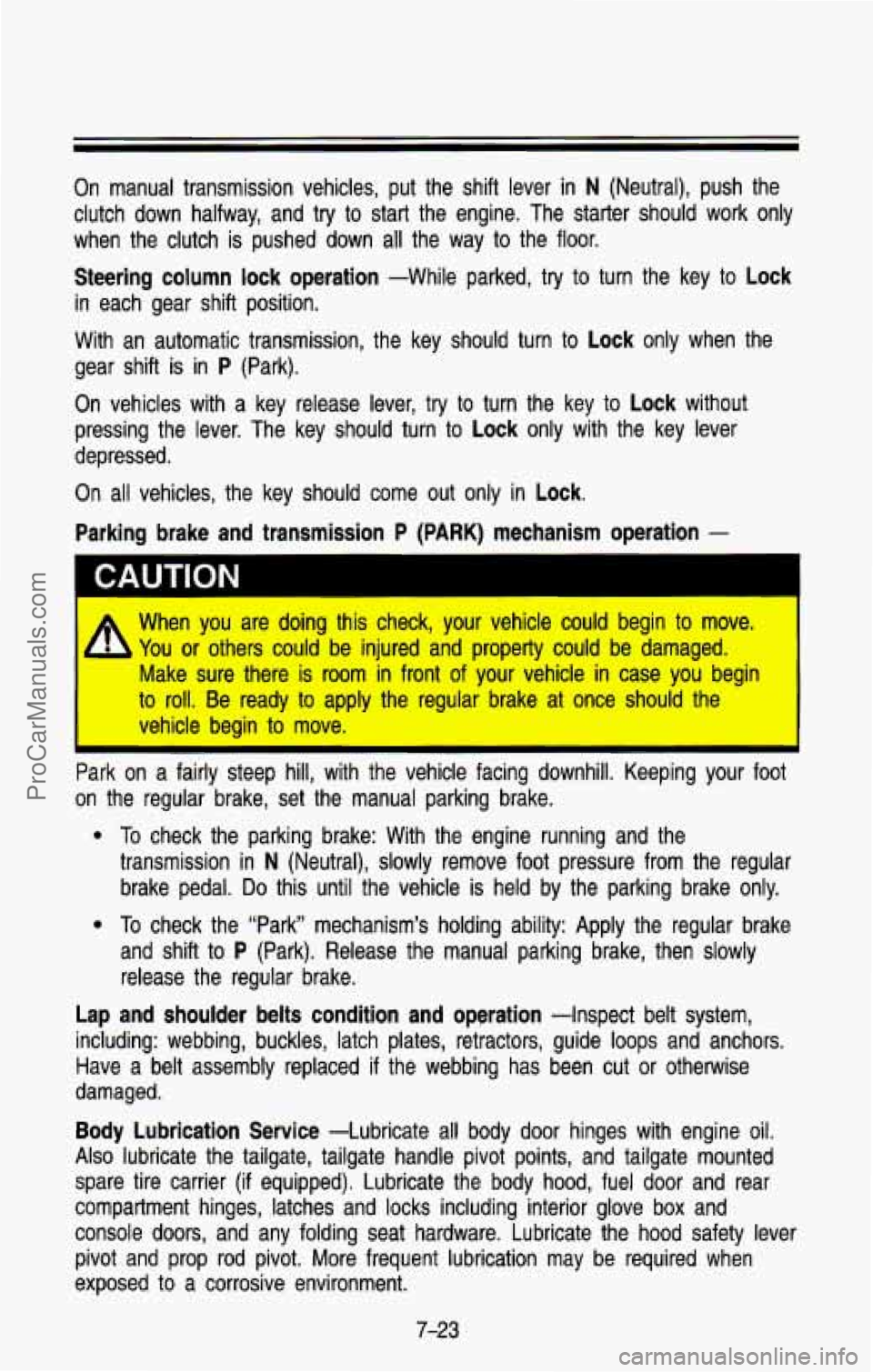
On manual transmission vehicles, put the shift lever in N (Neutral), push the
clutch down halfway, and try
to start the engine. The starter should work only
when the clutch is pushed down all the way to the floor.
Steering column lock operation -While parked, try to turn the key to Lock
in each gear shift position.
With an automatic transmission, the key should turn to
Lock only when the
gear shift is in
P (Park).
On vehicles with a key release lever,
try to turn the key to Lock without
pressing the lever. The key should turn to
Lock only with the key lever
depressed.
On all vehicles, the key should come out only in
Lock.
Parking brake and transmission
P (PARK) mechanism operation -
A
When you are doing this check, your vehicle could begin to move.
You
or others could be injured and property could be damaged.
Make sure there
is room in front of your vehicle in case you begin
to roll. Be ready to apply the regular brake at once should the
vehicle begin to move.
Park on a fairly steep hill, with the vehicle facing downhill. Keeping yo\
ur foot
on the regular brake, set the manual parking brake.
CAUTION
To check the parking brake: With the engine running and the
transmission in
N (Neutral), slowly remove foot pressure from the regular
brake pedal.
Do this until the vehicle is held by the parking brake only.
To check the “Park” mechanism’s holding ability: Apply the \
regular brake
and shift to
P (Park). Release the manual parking brake, then slowly
release the regular brake.
Lap and shoulder belts condition and operation -Inspect belt system,
including: webbing, buckles, latch plates, retractors, guide loop\
s and anchors.
Have a belt assembly replaced if the webbing has been cut or otherwise
damaged.
Body Lubrication Service -Lubricate all body door hinges with engine oil.
Also lubricate the tailgate, tailgate handle pivot points, and \
tailgate mounted
spare tire carrier
(if equipped). Lubricate the body hood, fuel door and rear
compartment hinges, latches and locks including interior glove b\
ox and
console doors, and any folding seat hardware. Lubricate the hoo\
d safety lever
pivot and prop rod pivot.
More frequent lubrication may be required when
exposed to a corrosive environment.
7-23
ProCarManuals.com
Page 381 of 386
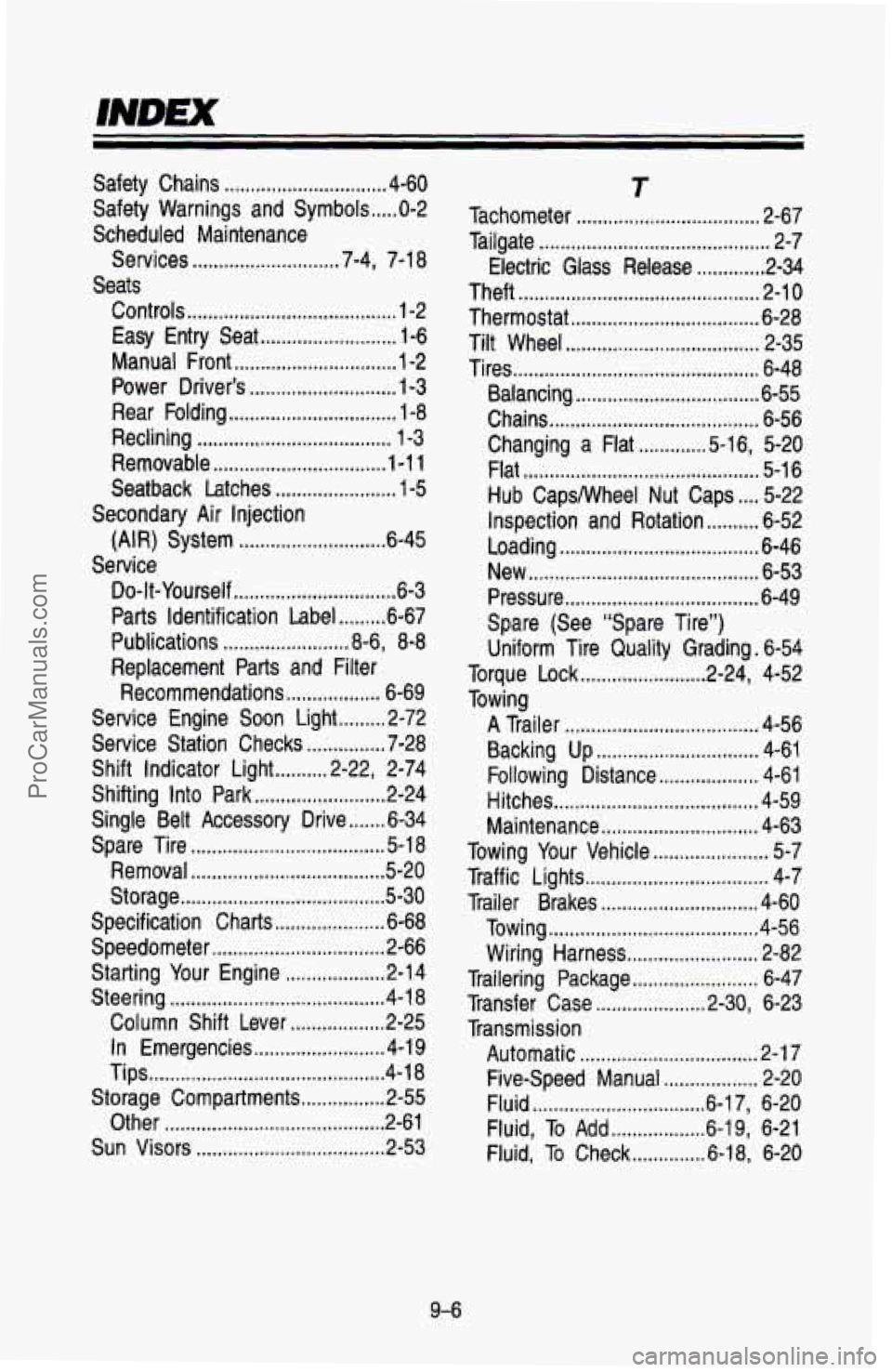
Safety Chains ............................... 4-60
Scheduled Maintenance
Seats Safety Warnings and Symbols
..... 0-2
Services
............................ 7-4, 7-1 8
Controls
........................................ 1-2
Easy Entry Seat
.......................... 1 -6
Manual Front
............................... 1 -2
Power Driver‘s
............................ 1-3
Rear Folding
................................ 1-8
Reclining
..................................... 1-3
Removable
................................. 1-1 1
Seatback Latches
....................... 1-5
(AIR) System
............................ 6-45
Do-It-Yourself
............................... 6-3
Parts Identification Label
......... 6-67
Publications
........................ 8-6, 8-8
Replacement Parts and Filter Recommendations
.................. 6-69
Service Engine
Soon Light ......... 2-72
Service Station Checks
............... 7-28
Shift Indicator Light
.......... 2-22, 2-74
Shifting Into Park
......................... 2-24
Single Belt Accessory Drive
....... 6-34
Spare Tire
..................................... 5-1 8
Removal ..................................... 5-20
Storage ....................................... 5-30
Specification Charts ..................... 6-68
Speedometer
................................. 2-66
Starting Your Engine
................... 2-1 4
Column Shift Lever
.................. 2-25
In Emergencies
......................... 4-1 9
Tips ............................................. 4-1 8
Storage Compartments ................ 2-55
Other
.......................................... 2-6 1
Sun Visors .................................... 2-53
Secondary
Air Injection
Service
Steering
......................................... 4-18
T
Tachometer ................................... 2-67
Tailgate
............................................ 2-7
Electric Glass Release ............. 2-34
Theft
.............................................. 2-10
Thermostat
.................................... 6-28
Tilt Wheel
..................................... 2-35
Tires
............................................... 6-48
Balancing
................................... 6-55
Chains
........................................ 6-56
Changing a Flat
............. 5-16, 5-20
Flat
............................................. 5-16
Hub CapsNVheel Nut Caps
.... 5-22
Inspection and Rotation
.......... 6-52
Loading
...................................... 6-46
New ............................................
Pressure ..................................... 6-49
Spare (See “Spare Tire”)
Uniform Tire Quality Grading
. 6-54
Torque Lock
........................ 2-24, 4-52
Towing
A Trailer ..................................... 4-56
Backing Up
............................... 4-61
Following Distance
................... 4-61
Hitches
....................................... 4-59
Maintenance
.............................. 4-63
Towing Your Vehicle
...................... 5-7
Traffic Lights
................................... 4-7
Trailer Brakes
.............................. 4-60
Towing
........................................ 4-56
Wiring Harness
......................... 2-82
Trailering Package
........................ 6-47
Transfer Case
..................... 2-30, 6-23
Transmission Automatic
.................................. 2-17
Five-Speed Manual
.................. 2-20
Fluid ................................. 6-1 7, 6-20
Fluid, To Add
.................. 6-1 9. 6-21
Fluid.
To Check .............. 6-18. 6-20
6-53
9-6
ProCarManuals.com